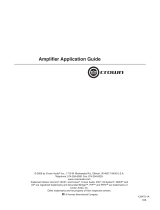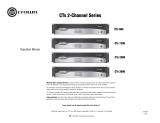Page is loading ...

127848-3
3/02
©
2002 by Crown Audio, Inc., P.O. Box 1000, Elkhart, IN 46515-1000 U.S.A.
Telephone: 574-294-8000. Fax: 574-294-8329. Trademark Notice: PIP is a
trademark and Crown , Com-Tech, Macro-Tech and P.I.P. are registered
trademarks of Crown International. Other trademarks are the property of
their respective owners.
∞∞
+ +

Page 2
P.I.P.–ATNJ
Reference Manual
∞∞
+ +
Fig. 1.2 Bottom View
Fig. 1.1 Front View

Page 3
P.I.P.–ATNJ
ference Manual
Reference Manual
Facilities
A. Balanced Input
These removable barrier-block con-
nectors (Figure 1.1) make it quick and
easy to attach an input cable with just
three screws. Once the cable is at-
tached, the connector can be quickly
unplugged and, if desired, moved to
a different amplifier.
B. Input Attenuators
Each channel has a calibrated at-
tenuator (Figure 1.1) for accurate
level adjustment. They have 21
detented positions which “click” into
place for ease of use.
C. Subsonic/Bass Switch
A 4-position slide switch for each
channel (Figure 1.2) controls the sub-
sonic/bass filter. This filter is an 18 dB/
octave Butterworth high-pass filter
which can be selected to attenuate
frequencies below 50 Hz, 100 Hz or
300 Hz. It can also be switched off
(FLAT). The switch positions are la-
belled on the circuit board between
the two switches.
D. Horn Equalization Jumper
A jumper is provided for each chan-
nel (Figure 1.2) to enable/disable the
constant-directivity horn equalization.
The jumper for channel 1 (EQ1) is
shown in the ON position while the
channel 2 jumper (EQ2) is shown in
the OFF position. This equalization
circuit is a 6 dB/octave shelving net-
work with a 3 dB rise at 3.2 kHz and
a peak boost of 12.5 dB at 24 kHz.
1 Welcome
Thank you for purchasing the Crown
P.I.P.
®
–ATNJ accessory.
PIP
™
(Pro-
grammable Input Processor) mod-
ules are designed to quickly install in
the rear panel of Crown
Com-Tech
®
,
Macro-Tech
®
or Studio Reference se-
ries amplifiers. Their versatile features
expand the capabilities of your ampli-
fier and enable you to customize it for
your particular needs.
You should find these items when you
unpack:
P.I.P.–ATNJ Module
Two 8-32 Phillips Machine Screws
Two Lock Washers
Two Quick-Disconnect Barrier
Blocks
This Reference Manual
Features
❏ Balanced inputs with 1:1 isolation
transformers to minimize input noise.
❏ RFI filter for attenuation of unwanted
ultrasonic frequencies. The RFI filter
is a 12 dB/octave, Bessel-tuned low-
pass filter with a 3 dB roll-off point at
33 kHz.
❏ Switchable subsonic/bass filter with
the following settings: flat, 50, 100,
or 300 Hz roll-off.
❏ Switchable constant-directivity horn
equalization network.
❏ Calibrated 21 position attenuators
give accurate level control of the in-
put signal.
❏ Removable barrier block connectors
provide greater wiring flexibility and
easy installation.

Page 4
P.I.P.–ATNJ
Reference Manual
Fig. 2.3 Installation into a
Standard PIP Amplifier
Fig. 2.1 Constant-Directivity Horn
Equalization (with RFI filter)
Fig. 2.2 Subsonic/Bass Filter Settings
2 Installation
Before installing this PIP module, it will
need to be configured. The first two
steps in the installation procedure fo-
cus on this. A phillips screwdriver is
required.
CAUTION: Before installing this or any
PIP in your amplifier, it is important to
turn down the amplifier’s level controls,
turn off the amplifier and disconnect the
AC power. Even though the amplifier is
off, there could still be enough energy in
the circuitry to cause electric shock.
Please note: The RFI filter is always
on—it cannot be switched off.
1. Adjust the constant-directivity
equalization jumper of each chan-
nel to be ON or OFF (see Figure
1.2). Figure 2.1 shows the fre-
quency response through the P.I.P.–
ATNJ when this filter is on.
(Flat, 50 Hz, 100 Hz, 300 Hz).
3. Turn the Attenuator controls of the
P.I.P.–ATNJ full counterclockwise to
∞ (full or infinite attenuation).
4. Turn down the amplifier level con-
trols (fully counterclockwise), turn
off the amplifier, and unplug it from
the AC power source.
5. Remove the existing PIP module or
panel (two screws). For PIP2 ampli-
fiers, this may involve disconnect-
ing the PIP from a PIP2 input
adapter (see Figures 2.4 and 2.5). If
a PIP2 input adapter is already
present, do not remove the ribbon
cables from the adapter. Otherwise
you will have to reconnect them in
the next step.
6. Standard PIP Amplifiers: Align the
edges of the P.I.P.–ATNB in the PIP
card rails and firmly push the unit in
until it is seated against the mount-
ing bracket (see Figure 2.3).
2. Select the desired position for the
Subsonic/Bass filter switch for each
channel. Sliding the switch to the
FLAT position switches off the filter.
The switch positions are identified
on the circuit board between the two
switches (see Figure 1.2). Figure
2.2 shows the frequency response
through the P.I.P.–ATNJ when this
filter is set in each of its four modes

Page 5
P.I.P.–ATNJ
ference Manual
Reference Manual
A
B
Fig. 2.4 PIP2 Input Adapter
Connection
Fig. 2.5 Installation into a
PIP2 Amplifier
PIP2 Amplifiers: (Requires the PIP2
ADAPTER.) Connect the PIP2 input
adapter to the two input cables of the
amplifier (see Figure 2.4). Notice the
PIP2 input adapter should be positioned
with the PIP edge connector on top and
facing away from the amplifier. The 20-
pin cable (A) is connected first, then the
18-pin cable (B) is connected. Both rib-
bon cables should extend below the
PIP2 input adapter.
Next, insert the edge connector of the
P.I.P.–ATNJ into the PIP2 input adapter
(see Figure 2.5) and insert the assem-
bly into the PIP opening in the back of
the amplifier.
7. Secure the P.I.P.–ATNJ with the two
screws and lock washers provided.
The lock washers are important be-
cause they bond the PIP to amplifier
chassis ground to ensure electrical and
mechanical integrity for safety and per-
formance.
8. Reconnect the amplifier to the AC
power and turn it on.
9. Connect the audio signal wiring to the
input connectors of the P.I.P.–ATNJ ac-
cording to the instructions in your
amplifier’s Reference Manual.
10. Adjust the amplifier level controls to
the maximum desired level. This should
be the maximum setting you ever want
the amplifier to use in case the Attenua-
tion controls on the P.I.P.–ATNJ are
ever set to 0 (zero) dB attenuation.
11. Use the Attenuator controls on the
P.I.P.–ATNJ. to adjust the input audio
signal level. Note: If you do not want to
use the Attenuator controls on the PIP,
turn them to 0 dB (full clockwise) and
use the amplifier level controls to adjust
the input audio signal level.
Do NOT change the circuitry. Unautho-
rized circuit modifications, void the war-
ranty.
Remember: Crown is not liable for dam-
age resulting from overdriven compo-
nents in your sound system.

Page 6
P.I.P.–ATNJ
Reference Manual

Page 7
P.I.P.–ATNJ
ference Manual
Reference Manual
127502
Rev A

Page 8
P.I.P.–ATNJ
Reference Manual
(subsonic/bass) filter has selectable –
3-dB roll-off points of 50, 100 or 300
Hz (see Figure 2.2). Constant-direc-
tivity horn equalization network has
3-dB rise at 3.2 kHz with 12.5-dB
peak at 24 kHz (see Figure 2.1). Both
these filters can be switched off if de-
sired.
A permanent RFI filter with a –3-dB roll-
off at 33 kHz also affects the response.
Attenuation: 21 position attenuator for
each channel. The attenuation settings
are: 0, .5, 1, 2, 3, 4, 5, 6, 7, 8, 9, 11, 12,
14, 16, 18, 21, 24, 30, 50 and
∞ (infi-
nite) dB.
Dimensions: 6
3
/8 x 1
7
/8 x 3
7
/8 in. (16.2
x 4.8 x 9.8 cm).
Weight: 12 ounces (340 grams).
3 Specifications
Note: All specifications referenced to
a 0.775-V input signal.
Signal to Noise: Better than –85 dB
(equivalent input noise) from 20 Hz to
20 kHz.
Common Mode Rejection: Better
than 60 dB at 1 kHz.
Crosstalk: –82 dB at 1 kHz.
Input Impedance: Nominally 10
K ohm.
Recommended Source
Impedance: 1 K ohm or less.
Maximum Input Level: +20 dB at 1
kHz.
Nominal Gain: Unity.
Frequency Response: ±1 dB from
20 Hz to 20 kHz when filters set flat
and horn equalization off. High-pass
If you have any questions, please contact:
Crown Factory Service
1718 W. Mishawaka Rd., Elkhart, Indiana 46517 U.S.A.
Phone: 800-342-6939 (North America, Puerto Rico and Virgin Islands)
or 574-294-8200 Fax: 574-294-8301
Internet: http://www.crownaudio.com
/




